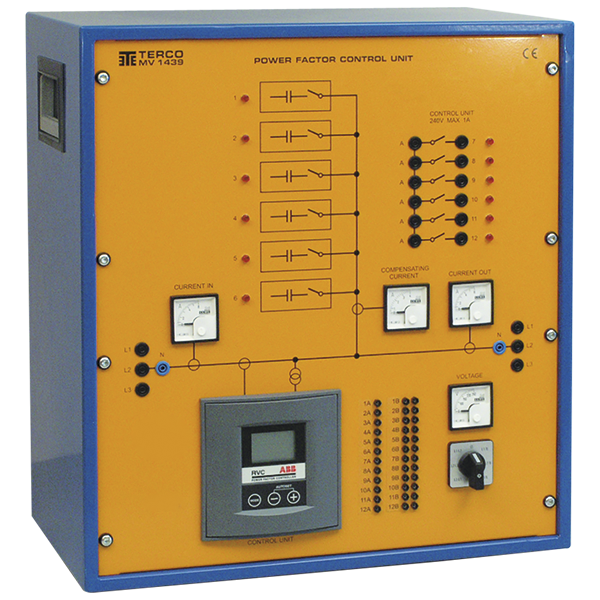Beskrivning
MV1439-235 Power Factor Control Unit (PFC) is also a module within our Classical electrical Machine Program.
With the PFC you can minimize the currents caused by reactive losses of power and thereby optimizing the transfer of energy between generation and loading.
This is becoming more and more important today when Saving energy is vital in a world with focus on pollution and shortage of energy.
Field of application
Inductive or mixed inductive and resistive networks in need of compensation, for example when starting and running induction motors.
Principles of operation
Depending on the power factor of the loading network a microprocessor will connect groups of capacitors.
By measuring phase voltages and current the microprocessor will calculate how many capacitive groups that has to be connected and also in which combinations.
| Electrical details | |
| Number of 3-ph groups | 6 |
| Power factor setting | 0.7 inductive to 0.7 capacitive |
| Nominal voltage | 3 x 230 V 50 60 Hz Code no. MV 1439-235 |
| Nominal power | 0 2 kVAr cap. |
| PF-Controller | Automatic or manual Adjustable delay times, switching sequences and strategies. |
| Monitoring and Measurement on the controller: | Voltage, Current and Power factor |
| Switching modes: | Linear and circular |
| Indication lamps: | Indication lamps for the capacitor groups which are connected |
Physical design
The Power Factor Control Unit is housed in a sturdy apparatus box with a clear mimic diagram explaining how to connect the supplying net from the left to the right side where the network in need for power factor compensation is connected.
Readings, parameters and sub parameters are indicated on the front of the controller. Other settings and programming than the defaults are simply performed from the keyboard and displayed on the controller front.
| General data: | |
| Power supply: | 1-ph 220 – 240 V, 50 – 60 Hz |
| Dimensions: | 510 x 570 x 280 mm |
| Weight: | 24 kg |
Typical Experiments with Terco PFC
- The concept of active power, apparent power and reactive power
- The concept of power factor and cos
- The concept of measuring methods
- Start current settings (C/k)
- Delay times
- Efficiency and losses
- Linear and circular switching modes
- PF-Controller design and schematics
- Programming the controller
- PF-Controller and resistive/inductive loads
- PF-Controller and induction motor loads
- Control range limits





